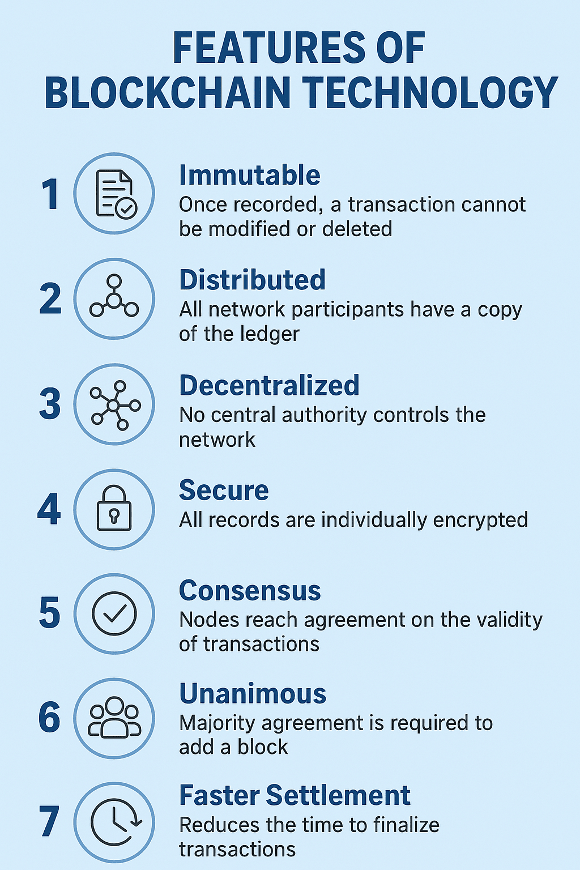Key Features of Blockchain with Examples
this is Key Features of Blockchain with Examples

Blockchain is often mistaken as being synonymous with Bitcoin, but in reality, it is much broader. While Bitcoin is a digital currency built on blockchain, the technology itself is a distributed digital ledger that records transactions in a secure, transparent, and tamper-resistant manner. Each block contains a set of transactions, identified by a unique cryptographic hash. If any change occurs within a block, its hash changes, making tampering immediately detectable.

The features of blockchain are what make it a game-changing technology across industries. Let’s explore them in detail:
1. Immutability
Immutability is one of blockchain’s most important characteristics. Once a transaction is recorded, it cannot be altered or deleted. This makes blockchain a permanent and tamper-proof ledger, ensuring a high level of security and trust.
- Every node (computer) in the network has a copy of the ledger.
- Transactions are only added after being validated by the majority of nodes.
- Once approved, the records become irreversible, protecting against manipulation or deletion.
This feature guarantees data integrity and provides confidence in the system.
2. Distributed Ledger
Instead of a single centralized authority maintaining the records, blockchain distributes them across all participants in the network.
- Every node keeps a full copy of the ledger, ensuring transparency.
- Any new transaction is validated by the network and updated across all copies simultaneously.
- No participant gets special privileges; every addition must be verified.
This distributed nature ensures faster updates, fewer errors, and resistance to fraud.
3. Decentralization
Blockchain operates without a central governing authority. Instead, it relies on a network of nodes working together.
- Eliminates the need for third-party intermediaries.
- Reduces the risk of single-point failures or shutdowns.
- Makes the system fault-tolerant and harder to attack, since hackers would need to compromise the majority of nodes.
- Gives users greater control over their digital assets without relying on banks or centralized systems.
This decentralization ensures fairness, openness, and resilience.
4. Security through Cryptography
Security is at the heart of blockchain. Each block:
- Has its own unique hash ID.
- Contains the hash of the previous block, linking them together cryptographically.
- Uses advanced encryption techniques to safeguard data.
Any attempt to tamper with a block would require changing the hash of every subsequent block—a practically impossible task.
5. Consensus Mechanism
To function smoothly, blockchain relies on consensus algorithms—rules that ensure all nodes agree on the validity of transactions.
- Nodes may not trust each other, but they trust the consensus rules.
- Common consensus mechanisms include Proof of Work (PoW), Proof of Stake (PoS), and others.
- Without consensus, blockchain would lose its reliability.
This ensures unbiased, efficient, and automated decision-making within the network.
6. Unanimous Validation
All participants must agree before any record is added.
- Majority approval is required to add a block.
- No single participant can independently change, delete, or add data.
- Updates propagate instantly across the network, ensuring synchronization.
This democratic process guarantees trust and integrity in blockchain.
7. Faster Settlement
Traditional banking systems often take days to finalize transactions due to intermediaries and verification steps. Blockchain eliminates these delays.
- Transactions are validated and settled almost instantly.
- Reduces costs and time associated with financial transfers.
- Provides significant benefits for industries such as banking, supply chain, and international payments.
Additional Features
- Smart Contracts: Self-executing agreements stored on the blockchain that trigger automatically when predefined conditions are met. These revolutionize business processes by eliminating intermediaries.
- Transparency: All records on a blockchain are publicly verifiable, ensuring accountability and resistance to fraud.
- Wide Applications: Beyond cryptocurrencies, blockchain is transforming industries like healthcare, real estate, supply chain, identity management, and even voting systems.
Test Your Knowledge
Practice what you've learned with these quizzes related to What is Blockchain?.
Continue Learning
Explore more topics in What is Blockchain? or browse other tutorials.